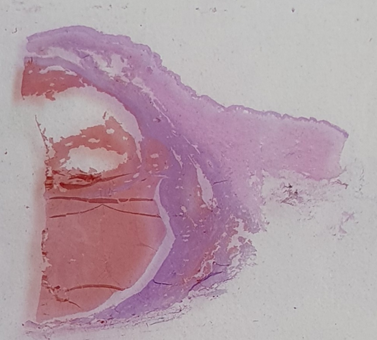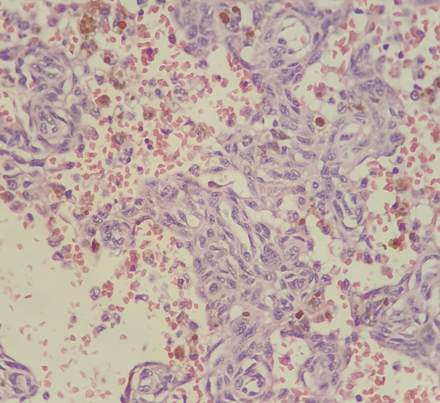Journal of
eISSN: 2574-9943


Case Report Volume 3 issue 6
1Dermatologist, State University of Londrina , Brazil
2Medical Student, University of Vale do Itajaí (Univali), Brazil
3Medical Student of Positivo University, Brazil
4Pathologist, Private laboratory, Brazil
Correspondence: Rogério Nabor Kondo, Dermatologist, Assistant professor of dermatology of Hospital, Universitário Regional do Norte do Paraná, State University of Londrina, Brazil, Tel 554333360144
Received: December 14, 2019 | Published: December 23, 2019
Citation: Kondo RN, Ramires LA, Liberatti FB, et al. Giant aneurysmal dermatofibroma: a case of the rare variant of dermatofibroma. J Dermat Cosmetol. 2019;3(6):159-161. DOI: 10.15406/jdc.2019.03.00136
Dermatofibroma is a benign skin tumor that may have a rare aneurysmal histological variant, aneurysmal dermatofibroma (AD). The diagnosis is by histological evaluation, which shows vascular spaces that dissect the tumor stroma, forming in some cases true venous lakes. However, AD is usually less than 20mm in diameter. We describe the case of a female patient whit a 45mm tumor in her right leg.
Keywords: dermatofibroma, neoplasm, skin, soft tissue tumors, hemosiderin, leg
Dermatofibroma or benign fibrous histiocytoma is a common benign skin neoplasia,1 but the aneurysmal variant of dermatofibroma called aneurysmatic dermatofibroma (AD) is a seldom cutaneous neoplasm (less than 2%).2 However, giant AD cases (larger than 20 mm) are more rare,2 as in the present case.
The purpose of the case report is to describe this special dermatofibroma sutype, rarely mentioned in the literature and its importance in the differencial diagnosis in relation to others types of tumors.
A 26-year-old female patient with a history of asymptomatic purpuric nodule in the anterolateral region of the right leg for 5 years. It began as ingrown hair. She had already performed hypertonic glucose for lower limb varicose veins, but none previous treatment had been done to tumor.
Dermatological examination revealed a nodule with a purpuric center of fibroelastic consistency, measuring approximately 45x35mm, in the anterolateral region of the right leg (Figure 1). The left inguinal lymph nodes were not enlarged.
Excisional nodule biopsy was performed for diagnosis. Panoramic photo of the microscopic slide shows the aneurysmal aspect of the lesion. It also shows cell proliferation in the more basophilic dermis with vascular spaces. A histopathology showed typical areas of dermatofibroma interspersed with foamy histiocytes, hemosiderin, and spaces that red blood cell without endothelial lining (Figure 2 & 3).

Figure 2 Panoramic photo shows the aneurysmal aspect of the lesion, with cell proliferation of the dermis and vascular spaces.

Figure 3 Microscopic examination. Typical areas of dermatofibroma interspersed with foamy histiocytes, hemosiderin, and spaces that red blood cell without endothelial lining.
Immunohistochemistry (IH) showed CD34 negativity, ruling out vascular proliferation. Five months later surgical treatment, the patient was able to walk without pain. She complained of discrete local paresthesia.
Dermatofibroma or benign fibrous histiocytoma is a benign neoplasia first described by Stout and Lattes in 1967.1 The aneurysmal variant of dermatofibroma was observed by Gross and Walbach in 1943, in which they discussed the relationship between it and sclerosing hemangioma. In 1966, Ariston and Reed described lesions that consisted of typical dermatofibroma areas interspersed with foamy histiocytes, hemosiderin, and spaces filled with red blood cells without endothelial lining. In 1981, Santa Cruz and Kyriakos named three of a series of 17 cases "aneurysmal fibrous histiocytoma", also called aneurysmal dermatofibroma (AD).2
The diagnosis of AD is established by histopathological findings.2-7 Dermal localized neoformation consists of myofibroblasts, spindle cells and hemosiderin-containing histiocytes in their fibrous stroma, Touton-type multinucleated giant cells, and “unendothelial” blood spaces occupying the most of the injury.2
Therefore, as these vascular spaces are not endothelial lined and are not abnormal dilations of the vascular system, it would be incorrect to use the term "aneurysmal". In addition, there is no vascular proliferation in AD, which makes the term “angiomatoid” incorrect as well.2
From an immunohistochemical point of view, dermatofibroma spindle cells have smooth muscle actin reactivity and CD57 show fibroblast and myofibroblast differentiation, being negative for factor VIII, desmin, CD34 and protein S-100,2 just as in the present case.
The etiology of AD is not very clear. For some authors this phenomenon could occur in areas of hypocellularity or secondarily to repeated trauma or microtrauma that would precipitate microhemorrhages.2 The patient in the case had a history of varicose vein glucose applications at the site.
AD usually presents with a single nodular lesion, 5mm to 20mm, brownish, dark red or black in color.2,4 The present case showed a 45mm lesion (giant AD), twice the size of the described variations. that, at first, suspicions of malignant tumors may be raised.
Differential diagnosis is established with benign vascular lesions such as hemosiderodic hemangioma and some malignant vascular lesions such as angiomatoid malignant fibrous histiocytoma (which affects the subcutaneous cell tissue, muscle and periosteum) and melanoma, whose histological aspects are totally different. Other differential clinical diagnoses include papular, nodular or plaque lesions of Kaposi's sarcoma (CD4 immunoreactive and absence of fibrohistiocytic cells).2
Treatment of choice is surgical resection.2-6 Surgical margin of at least 3 to 5mm is advised.2 According to some studies, the recurrence rate has been shown to be about 20%, and the clinical follow-up of patients.2,7
AD is a seldom variant of dermatofibroma and it has differencial diagnosis with others important types of tumor. The surgical resection is the treatment of choice.
None.
The authors report no conflicts of interest.
None.

©2019 Kondo, et al. This is an open access article distributed under the terms of the, which permits unrestricted use, distribution, and build upon your work non-commercially.